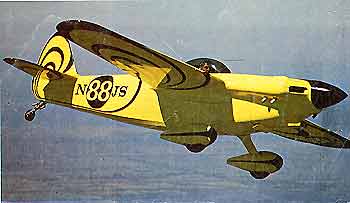
Yellow Jacket: Son of Shoestring
by
Budd Davisson
Time was, if you were a pilot flying in Formula One (Goodyear) races and your name wasn’t Ray Cote or Bill Falck, you didn’t race to win, you raced for third place because the other two always occupied the first two spots.
By 1950, the pattern was only broken occasionally: Bill Falck and Rivets would dominate the race if it was at a lower altitude and Ray Cote (pronounced Cotey) would take the races held at higher altitude airports because his airplane, Shoestring, had a higher aspect ratio. This enabled Cote to turn the pylons slightly tighter than Falck in the thinner air
Shoestring had the kind of look that said it just had to fly great. And that’s what was on my mind as I prepared to fly Yellow Jacket, the first replica to be built of Shoestring. Jim Strode, the builder, kept telling me it flew like a Cub, but I had a hard time believing that. If nothing else, just getting down into the cockpit dispelled the Cub comparison: you have to keep your legs absolutely straight and support yourself by your arms while sliding your legs under the main spar. Is it tight? Yeah, like a wet suit. And then you feel like a prairie dog peeking out of your burrow, as wings, nose, canopy combing all seem to come right up to your chin.
Yellow Jacket had a 100 hp, 200 cubic inch Continental, which became the standard engine for Formula racers. It is also the engine that powers thousands of Cessna 150’s. Somehow, I had the feeling Yellow Jacket wasn’t going to fly like a 150.
I taxied out—no let me amend that—I started to taxi out, but had to stop and get out to give my cowboy boots to someone: I couldn’t move the rudders without getting brake so I flew it bare foot.
When I bought the power up, the coarse pitched prop was slow to get me moving, but, as it accelerated, that changed quickly. I let it fly itself off the ground at around 100 mph and continued climbing at 110mph. And boy does it ever climb! Even with that prop it was going up over 2,000 feet per minute.
As I pushed the airplane into level flight, the speed quickly jumped to 175 mph indicated, which was around 185 mph true and planting the throttle against the stop gave a solid 190 mph indicated, which is well over 200 mph at that altitude. How’s that for 100 hp? A racing prop would have added at least 15 mph.
When you’re rocketing around in a sweet handling little speedster like this, it’s impossible not to do something with it so I looped and rolled until the dwindling fuel supply it was time to go home.
The airplane is so clean it took a few high “G” turns to burn off speed and get down under 90 mph and the approach was really flat. However, even at 85 mph over the fence, it floated and floated, and….. I was glad I had a long runway in front of me.
Although it has the neutral stability of a racer, it’s hard to imagine a sport airplane with more overall efficiency and fun packed into such a tiny bundle.
Want another Peanut Pirep? Return to PEANUT.
For a full pilot report go to Shoestring